Introduction
Ventilation systems are important to a healthy, comfortable indoor environment. After sealing a house as tightly as you reasonably can, I strongly recommend installing a simple mechanical ventilation system to provide controlled air exchange. This system should include local spot ventilation in bathrooms and kitchens, as well as some type of automatic, full-time background ventilation. The back ground ventilation may be easily and inexpensively integrated with bathroom exhaust fans or with a heating or cooling system. More comprehensive, whole-house ventilation systems are the best choice for controlling air exchange and filtration, but they can be consider ably more expensive This section will outline the basic options for house ventilation systems and describe how they are installed.
Do I Need a Ventilation System?
Tip: A tight building envelope is an essential part of a ventilation system, without it, you have no control of the air-exchange rate.
WHAT CAN GO WRONG: In hot, humid climates, ventilating a house with outdoor air may actually introduce moisture. Although fresh-air ventilation is still important, including spot- ventilation in the kitchen and bathrooms to exhaust moisture, ventilation rates should be lower. It is also important to supplement ventilation with adequate dehumidification, through air-conditioning or other mechanical systems.
More Details: A whole-house fan, typically installed to exhaust a large volume of air into the attic, is often effective at offsetting air-conditioning needs in the summer, but it is too large and powerful to provide a continuous background source of fresh air.
Why make a house tight, and then spend money to ventilate it? Doesn’t it make more sense to just leave it a little bit leaky? The short answer is, “No”. A leaky house experiences haphazard ventilation that may or may not be appropriate or adequate. A good ventilation system, on the other hand, allows you to control the introduction of fresh air into a home.
Fresh-air ventilation can help dilute pollutants in the home, manage moisture, and improve air quality. It is not something you install to compensate for a tight house. It should he installed in every house, and the house must he tight — that is, properly air-sealed and insulated before ventilation can work properly. A tight building envelope is an essential part of a ventilation system: without it, you have no control over the air-exchange rate.
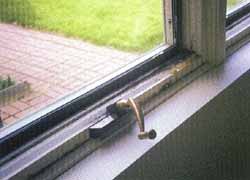
Interior moisture problems, such as excessive window condensation,
mildew growth, or peeling paint, may indicate that you need a fresh-air
ventilation system.
Dehumidifiers
If you live in a region that has mild, rainy winters, such as the Pacific Northwest, or in a hot, humid climate, air exchange will not reduce the relative humidity in the house for much of the year. You should consider using a high-efficiency dehumidifier, either integrated with the supply air-stream of your ventilation equipment or used as a stand-alone unit. The high-capacity, ultra-efficient dehumidifier shown here is available in a stand-alone model or a standard model that connects to a central ventilation system for automatic dehumidification. If you need a dehumidifier for indoor humidity control, choose one that’s Energy-Star rated.
“A house has to breathe...”
One of the wonderful qualities of the human, respiratory system is that its level of activity adjusts to your needs. When you are active, you breathe quickly to increase the incoming oxygen flow; when you are at rest, your breathing slows. If a ventilation system acts as the lungs of a house, then it too needs to be capable of adjusting its airflow rate, depending on your family’s ventilation needs. A good fresh-air ventilation system allows you to change the ventilation schedule, or vary the rate of airflow so that you can add extra ventilation which the house is full of people or turn it off completely when no one is home.
As for operating costs, in most climates a very tight home with mechanical ventilation is less expensive to operate than a leaky house. One big advantage of ventilation control is that you can set the air-exchange rate independently of outdoor conditions. If you leave ventilation to random air leaks, you get too much airflow when it’s cold and windy outside (and fuel costs more) and not enough when the weather is mild. Of course, controlling moisture sources, such as a crawl space floor or improperly-vented combustion equipment should be dealt with first.
Ventilation systems typically provide better indoor air quality, while reducing the need for building maintenance. Some of the indications that you may need ventilation include mold, mildew or window condensation in your home. A stuffy-smelling house, cooking odors that linger for hours, and chronically peeling paint may also indicate high indoor humidity levels. If your house has any of these symptoms, fresh-air ventilation is likely to help.
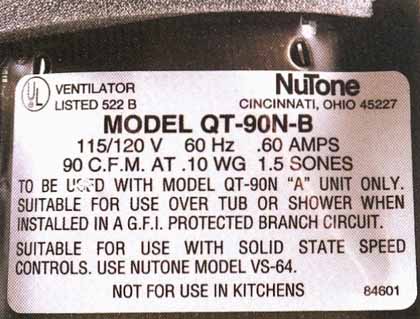
A Home Ventilating Institute (I-WI) sticker shows a fan’s
airflow rating in cubic feet per minute (cfm) and its sound level in
sones.
According to Code
Code requirements for bathroom ventilation are usually satisfied by an operable window, but most people simply don’t like to open bathroom windows in the winter. Every bathroom should have an exhaust fan of at least 50 cfm. Range hoods rated for at least 250 cfm are also highly recommended, but they are not usually required by code (though that may be changing). Bathroom and kitchen exhaust fans should always vent directly outdoors.

Kitchen exhaust hoods are more effective at a lower airflow
than the popular downdraft exhausts are. Due to the grease and fire hazard,
make sure the equipment and ductwork is rated for range applications.
Types of ventilation systems
A background ventilation system is designed to provide a minimum amount of fresh outdoor air to the living space year-round. This type of system runs either full-time at an adjustable rate or on a schedule that you set according to your needs. Two simple, inexpensive background ventilation systems I have used successfully are the bath-fan ventilation system and the return—air ventilation system. The installation for these systems is covered in a following section. Types of whole-house ventilation systems include central exhaust systems and heat-recovery ventilation (HRV) systems, which are more complex, more effective, and more expensive.
Every house should also have spot ventilation: an exhaust fan in each bathroom and a range hood in the kitchen. The range hood is particularly important with a gas range or oven, which may produce carbon monoxide as well as water vapor. The warm, moist air exhausted from kitchens and bathrooms must be vented to the outside, not into an attic or back into the room.
IN DETAIL: If you can vent an exhaust fan horizontally through a wall, a standard 4-in. or 6-in, exhaust hood with a flapper will work fine. However, to avoid long duct runs that drastically reduce air flow, it’s sometimes necessary to vent it vertically through the roof. In that case, you’ll need a roof jack as shown below. Be sure to follow the installation instructions carefully and make sure that the flashing tucks under the roofing shingles to avoid teaks.
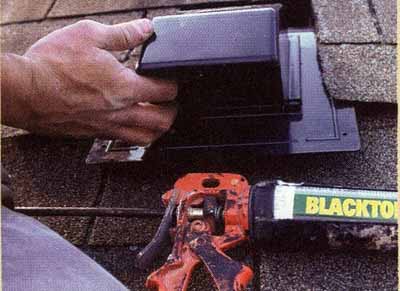
SAFETY FIRST: Don’t attempt to do the wiring for a new fan or controller unless you understand the safety and code requirements, and always turn off the appropriate circuit breakers before working on electrical circuits. This part of the job is best left to an electrician.
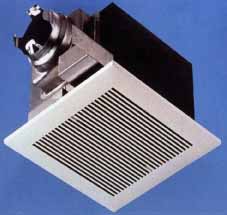
Several manufacturers make bathroom fans that are quiet and
long lasting and use very low power. This Panasonic WhisperCeiling is
one of my favorites because it is so quiet (a 70-cfm model is 0.9 sones;
a 50-cfm model is 0.5 sones).

One advantage of a through-wall fan is that you don’t need
to install ductwork (with its associated drop in airflow).This model,
the Pre-ventilator from Tamarack Technologies, has a motorized cover
that seals tightly when it’s turned off. Both Fantech and Panasonic also
make through-wall fans.
Simple Ventilation Systems
The simplest type of background ventilation system is an exhaust-only, or supply-only, ventilation fan. An exhaust-only system draws outdoor air inside through small cracks and gaps that already exist, even in a tightly sealed house. I have seen it used successfully in hundreds of new homes—some of which are extremely tight—as well as retrofitted to solve moisture problems.
Bath-Fan system
To set up a bath-fan background ventilation system, first choose a bathroom -- the one that is either most used or most centrally located -- in which to set up a controlled fan. If you need to replace an existing fan, choose a bathroom with an accessible attic area above. You may have an exhaust fan already, but it’s unlikely that it will meet the requirements: it must be quiet, moderately powerful, and rated for continuous operation.
Most fans are rated for noise and airflow by the Home Ventilating Institute (HVI). Noise is rated in sones—the higher the sone rating, the more noise it makes. We feel that fans with sone ratings of greater than 1.5 are too noisy for this application; if you can, choose a fan rated at 1.0 or less. For most homes, choose a fan rated between 70 and 120 cubic feet per minute (cfm). In hot, humid climates, lower airflows of 50 cfm to 90 cfm may be adequate.
To do its job properly, a fan must be vented to the outside and have a duct run that is as short and direct as possible. If you can’t reach an exterior wall or gable end within about 10 ft., you may be able to put in an elbow and vent it straight up to a roof-jack. Always use rigid-metal duct (4-in, or 6-in, diameter); if the duct runs through an attic or other unheated space, be sure to insulate it with vinyl-covered duct wrap.
If you don’t have access to add or replace a bath room fan because there’s no attic space or there is limited depth in the ceiling joists above, another option is to install a wall-mounted fan. Several models are available for through-wall mounting that are quiet and use very little power. Another less- desirable option is to place the fan in another area of the house that’s more accessible. Keep in mind, though, that bathrooms are where the moisture is. I’d put an automatically controlled fan in another part of the house only if there are operating bath fans that are already vented to the outside. It will cost in the range of $175 to $325 for the necessary parts (including fan, ductwork, and controls).
Ventilation Ductwork
Small home ventilation fans are typically rated very optimistically for airflow. You may think that as long as a fan can blow air into a duct, air a must come out at the other end. But if there’s too much friction—caused by rough inner surfaces, too many elbows and bends, or a run that is too long—the fan can just spin in place, and virtually no air will come out.
What to do? First, stay away from flex duct. Whether it’s inexpensive 4-in.-dia. vinyl dryer hose or 6-in.-dia. or larger insulated duct, flex duct is cheap, fast, and easy to use, and it fits easily in tight spaces. But there’s a heavy price for convenience: All the coils and rough surfaces add resistance and slow the airflow. If you have a long run of flex duct and a few sharp bends, you can assume, at best, 50% of a fan’s rated cfm—and you may get nothing at all!
Instead, use smooth, rigid-metal ducts when ever possible. Plan your ducts to keep the runs short, and keep the elbows and fittings to a mini mum. With this approach, you can expect to get about 15% to 20% less than the fan’s rated air flow. For a complex, central ventilation system, I recommend hiring an HYAC contractor who knows how to design ductwork for proper air flow, using the “equivalent length” method.
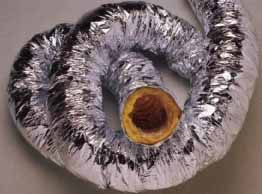
Flex duct, though easy to install, can seriously reduce airflow
in residential ventilation equipment.

Rigid-metal ducts provide higher airflow with lower friction
and give you the maximum performance from your fan.
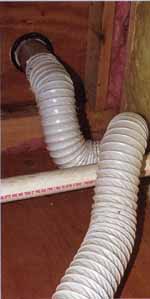
A contorted, vinyl flex hose is fairly typical. Not only do
installations like this one fail to provide the required airflow, but
low spots can trap water in cold weather or even fill with ice, which
completely stops airflow. Flexible aluminum is not much better; fans
should be ducted with smooth, rigid metal (or PVC pipe) whenever possible.
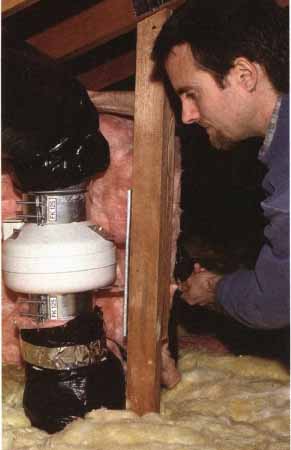
One common type of central exhaust fan is the in-line
fan, made by Fantech and a number of other manufacturers. These fans
can be sized to exhaust several bathrooms, and they may be mounted
in the attic or basement for quiet operation and easy service. Note
that the attic-mounted, rigid-metal ductwork and fan are fully insulated
to prevent interior condensation.
Safety: Some people are concerned that exhaust fans may backdraft heating or hot water equipment. Typically, the fans that contribute to backdrafting are the large ones, including those for a dryer, central vacuum, or commercial kitchen exhaust hood or downdraft vent. Theoretically, a fan of I 20 cfm could backdraft a water heater, but it is highly unlikely. A fan of 300 cfm is more likely to be dangerous, but only in a very tight house.
Ventilation controls
To be considered a background ventilation system, the fan must be capable of running on a regular schedule or continuously, if necessary There are several timers that can control fan speed, operating times, or both. When you’re choosing a controller for your ventilation fan, check with your supplier to make sure that the controls are compatible with the equipment you are using. Regardless of the control you choose, I recommend first setting the fan to run about half the time, at least during the hours people are regularly home. Then you can adjust it to run more or less, as needed.
I usually install Airetrak or Aube controls in the bathroom, as they have a built-in boost override and the timing functions are hidden from view You can put the 24-hour dial timer in the bath room, but it’s ugly and it shouldn’t be used for day-to-day on/off overrides. I try to put that timer in a laundry area, utility room, or basement stairwell or near the electrical panel—somewhere convenient and accessible but not that visible.
TIP: Regardless of the ventilation system, start by setting the control to run it half-time, then adjust as necessary
PRO ADVICE: Some ventilation experts have suggested the use of fresh air inlets, which are essentially intentional holes in the building envelope. However, research (and experience) has shown that these inlets often don’t work as intended—air is just as likely to go out as to come in. Save your money: These inlets are really not necessary in any but the very tightest single-story house.
CAUTION: One drawback of the simple exhaust ventilation system is that there is no control over where the makeup air comes from. Although it is generally dispersed throughout a building, makeup air may derive from leaks in basements, garages, or other places with pollutant sources. Remember: Source reduction is the first step toward improving indoor air quality.
Controls for Simple Ventilation Systems
A 24-hour timer (see the center object in the of photo above) provides flexibility and is easy to set and adjust. It controls the background air exchange—you need a separate switch to override the program, so that the fan can be turned on whenever it’s needed. (Either of the switches shown in the photo at right is better than a regular switch, because it can run the fan for 20 or 30 minutes after you leave the bath room and exhaust all the moisture after taking a shower.) This system does need more wiring; I recommend locating the dial timer where you can reach it easily but do not have to look at it every day.
The Airetrak (see the left object in the photo above) is a good alternative when you want to replace an existing wall switch but don’t want to add a new electrical box for a timer. This unit can be set at varying fan speeds and/or hourly timed settings. The button overrides the program and runs the fan for 20 minutes, then automatically goes back to the program. The speed control tends to make the fan noisier, so I recommend setting the Airetrak for full speed, using part-time operation every hour to obtain the desired air exchange. This unit runs the same program every hour, making it less flexible than the 24-hour timer.
A third control, made by Aube (see the right object in the photo at left), provides up to seven on/off cycles, each of which can be set daily or weekly. Although it can’t provide short on-and- off cycles every hour, it is somewhat more flexible and less expensive than the Airetrak.
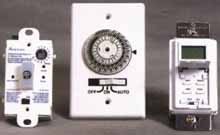
Left: The Airetrak is a special timer that can run the
fan every hour, at any interval from 5 minutes to full-time; the push
button overrides the program for on-demand ventilation. Center:
A 24-hour dial timer fits in a single-gang box and allows on- and off-times in 20-minute increments. Right: This timer by Aube provides customized daily programs and a manual over ride button that lifts up to reveal the programming area.

The fan delay timer switch at left turns on a bath fan
when you switch it on, but when you switch it off, the fan runs for a
preset time that can be adjusted from I to 60 minutes. It can also turn
a light on and off without the shutoff delay. The windup timer at right
is much simpler, allowing you to select the shutoff delay when you activate
the fan. Both models allow you to run the fan for a period of time after
you leave the bathroom, ensuring good moisture removal. If you use a
24-hour timer to program a ventilation system, either of these switches
may be wired to over ride the program for on-demand bathroom ventilation.
Return-air system
If you have a ducted, central-air system for heating and/or cooling, another inexpensive (between $200 to $300 for parts) ventilation option is a supply-only system ducted through the furnace or air conditioner’s air handler. This system pulls in fresh outdoor air whenever the air handler runs and distributes it throughout the house.
Although a simpler version of this system is common in some parts of the United States, most installations lack three important elements. First, a motorized damper is essential on the fresh—air- inlet duct—preferably where the duct enters the house. This prevents air from coming in through the duct when ventilation is not needed. Next, a timer is necessary to ensure that the air handler runs regularly, ventilating the house when there is no call for heating or cooling. This ensures a mini mum ventilation rate year-round. There are a couple of timers that can handle this function. Finally, insect screening at the inlet hood is important, and it must be kept clean. With a return-air fresh air system, it is also very important to locate the outdoor-air inlet far from potential sources of pollution, such as a dryer, combustion appliance vent, the garage, or the driveway.
If your house has an existing forced-air system, a return-air system may offer better overall ventilation than a bath-fan system, though it may be less cost- efficient. For example, a 20-watt bath fan running 100% of the time may cost less than $20 per year in electricity; a furnace fan running a third of the time may cost between $30 and $120 per year. If you have an old furnace with a high-wattage blower motor, a return—air system is less desirable due to the higher cost of operating the blower motor. And if your central-air handler is noisy, your ventilation will be, too. However, this system has two major advantages: First, fresh air is drawn from a known place and can be filtered. Second, unlike a bath-fan system, it circulates fresh air throughout the house.
TIP: A central ventilation system should provide 10 to 15 cfm of airflow per person Plan for a minimum of 15 cfm per bedroom, plus an extra 15 cfm. This flow hood is one way to accurately measure the airflow at all the registers of your ventilation system.
WHAT CAN GO WRONG: I’ve tested a lot of ventilation systems — central exhaust only and HRV — that have low or poorly balanced airflows. If you install (or have installed) a central ventilation system, make sure the ducts are designed for adequate airflow from all registers. One critical element is an adjustable damper in every branch duct. After the system is in, it’s a good idea to have it checked by a professional with a flow hood or an anemometer to make sure the ducts are adequate and the system is balanced.
Central Ventilation Systems
In addition to the simple ventilation systems mentioned previously, central-fan ventilation systems can be set up either to provide fresh air to bed rooms and living areas or to exhaust stale air from bathrooms and the kitchen. These systems may be more effective than the single-point exhaust or supply-only air systems mentioned earlier, but, because they require quite a bit more ductwork, they are more expensive to install and more difficult to retrofit in an existing home.
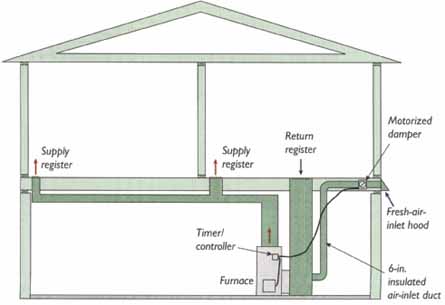
Return-Air Ventilation System: This simple ventilation
system draws outdoor air through a screened inlet, mixes it with house
air, and sends it to the furnace, where it is distributed throughout
the house. The motorized damper and the fan controller are essential
for managing the ventilation rate. The inlet duct should be made of sheet
metal and be as short and direct as possible. It should enter the return
duct as close as possible to the furnace, but not between the furnace
and the furnace filter.
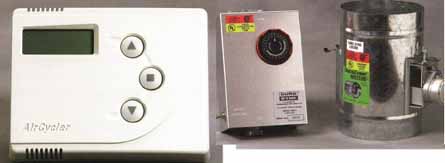
(far left) The AirCycler FR-V can run a central air handler
fan for ventilation, when it’s not already being used for heating or
cooling purposes, at any preset interval you wish. It can also control
a 24-volt motorized damper (not shown). EFI sells a kit that includes
the AirCycler timer, a Hoyme damper (Hoyme Model HAC 061 0-0PO), and
a 6-in. outdoor hood. (center) A motorized damper (right)
by Duro Dyne is an essential component of any return-air ventilation
system. It can be controlled with Duro Dyne’s AQC- I Air Quality Control
Center, provides 24-hour, 15-minute-interval control of air handler
ventilation cycles, and also controls a 110-volt exhaust fan. This
sturdy, well-built unit doesn’t keep track of thermostat calls, as
the AirCycler does, but it can be set to ventilate
differently at various times of day.
Central-exhaust / supply-only systems
Central-exhaust systems are more common than central supply-only systems. They use a central fan, typically located in a basement or an attic, to exhaust air from several points in the home at the same time. One major advantage of those systems is that the equipment is easy to service. For example, a single central fan located in a basement or an attic is easy to reach for repair or replacement. Those systems may also be quieter than the simple systems mentioned earlier, but that depends on the location of the fan and the care taken to install vibration dampers on the fan and ductwork. The cost in materials for central exhaust systems ranges from $250 to $400.
Ideally, a ventilation system should provide 10 to 15 cfm per person. I usually size a fan for a minimum of 15 cfm per bedroom, plus an extra 15 cfm for the master bedroom: a 3-bedroom house needs 60 cfm; a 5-bedroom house, 90 cfm. For flexibility, it’s a good idea to size central systems for 50 cfm to 100 cfm more than the minimum requirement; you can always use a variable—speed control or timer to reduce the background ventilation rate. And, don’t forget, airflow is generally lower than the fan’s rating, so add another 20% to 25% to the desired flow to achieve the appropriate cfm rating.
Central-exhaust systems typically are designed to draw air from bathrooms, the kitchen (but not from over the range), the laundry room, and other areas that have moisture or stale air. Usually, they are run at a low speed with a variable-speed control for continuous background ventilation. An override switch or windup timer is usually placed in bathrooms when a temporary full-speed boost is needed to provide maximum ventilation.
One disadvantage of a central-exhaust system is the greater electricity cost compared to that of a single high-efficiency bathroom fan. In addition, if it’s ducted to too many locations, it doesn’t always provide really good spot exhaust for bathrooms during boost mode.
Central supply systems use a fan and ductwork much like central-exhaust systems, but they bring fresh air from a known outdoor location and deliver it to the living space and bedrooms. This has a clear advantage, because incoming fresh air is filtered and delivered by ducts throughout the living space. However, in cold weather, the fresh air can create uncomfortable drafts, so the ducts must be placed very carefully Also, separate spot-exhaust ventilation fans are still needed, increasing the cost of the entire system.
Heat systems
If you want a top-shelf ventilation system, you should consider one of the heat-recovery systems. These systems typically pull warm exhaust air from bathrooms and the kitchen and run it through a heat exchanger to preheat incoming fresh air. This warmed fresh air is then delivered to living areas and bedrooms. The stale and fresh airstreams don’t mix but move in parallel through a series of flat plates that provide a lot of surface area for heat exchange. This way, the systems can recapture 65% to 80% of the heat from the outgoing airstream, which makes them real energy savers. And because they balance both supply and exhaust airflows, heat-recovery systems are the least likely to backdraft combustion equipment.
There are two kinds of heat-recovery systems: heat-recovery ventilation (HRV) and energy-recovery ventilation (ERV). HRVs are most efficient in cold weather. ERVs transfer not only heat but also humidity, using a special heat-exchanger wheel or core. This humidity exchange improves efficiency during the summer in humid climates, because it saves on the dehumidification load that air conditioners need to provide. This saves more energy and helps reduce moisture problems.
HRV and ERV systems are much more expensive than the simple systems outlined previously; they range from $1,500 to $4,000 installed (including labor). Installation of these systems is better left to a professional. There are some clear advantages for the price: The systems do a much better job at ensuring whole-house ventilation, and they are the system of choice for extremely tight homes and for people with respiratory sensitivities, because they filter incoming fresh air. They may even be cost-effective (meaning they will actually pay for themselves in energy savings) in some climates, but not unless you first make your house very tight. Depending on the unit, run time, climate, and fuel costs, HRV and ERV systems will probably save between $100 and $500 per year.
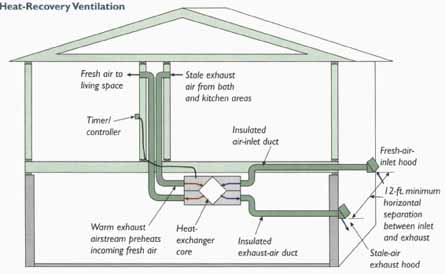
Heat-Recovery Ventilation -- A heat-recovery system uses the
heat from the exhaust airstream to preheat incoming fresh air. The fresh
air is ducted either directly to living areas or to the return plenum
of a furnace air handler for distribution throughout the house. In hot
weather, the exhaust airstream pre-cools incoming fresh air.
TIP: Depending on the unit, run time, climate, and fuel costs, HRV and ERV systems will probably save between $100 to $500 per year.
Caution: Although some installers claim that an HRV will solve all your ventilation needs, even a large unit may not adequately remove moisture from bath rooms, especially if the exhaust ducts vent to many locations. In my experience, it’s better to use a smaller HRV unit that is sized for the background ventilation rate (100 cfm to 150 cfm for most homes), then install separate exhaust fans for removing steam in the bathrooms.
FYI: If you think you want a heat- recovery ventilation system, don’t be too concerned about payback. After all, a ventilation system costs money to buy and operate. The value of that investment is priceless: It gives you control over air exchange and moisture, and it provides better indoor air quality for your family. The value of central systems and heat recovery for homes stems more from the added control of incoming and exhaust airstreams and filtration opportunities; the heat and/or energy recovery is an added bonus.
Next: Insulating a House
Top of page Related Articles Home